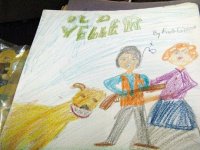Beyond the Book Report: Ten Alternatives
Your content has been saved!
Go to My Saved Content.In my last post I described 10 ways to cultivate a love of reading in kids. I want to expand on that theme by suggesting 10 alternatives to the book report. I'm not a fan of book reports; I don't think they are an effective way for a student to demonstrate understanding of a book and I don't think they help students enjoy or appreciate reading.
Let's consider some activities that allow a student to show understanding of a book and that might be enjoyable. This selection of activities is also intended to meet the needs of different kinds of learners -- or to contribute to the development of skills beyond writing. I often allowed students choice in deciding how they wanted to respond to a book -- they could choose from a list like the one below.
1. The Graphic Novel: Students draw scenes from a selected part of the book-perhaps a scene that represents the beginning, middle and end if you're working on understanding chronology; or three scenes that depict how the main character changed. If the book is rich in setting, then asking them to illustrate where the story takes place can also be revealing. Drawing will help students remember or find details. Then you can also ask them to highlight or copy the textual evidence for their illustrations.
2. An Alternative Ending: Asking students to create an alternative ending to a book -- one that makes sense -- pushes them to really demonstrate an understanding of characters and plot. What makes a gripping novel is often that you don't know what's going to happen in the end. Asking students to diverge from but build on a writer's style is very hard -- and an exciting challenge for skilled readers.
3. A Sequel: Sequels are also fun for kids to write. How many of us have reached the end of a book and wanted more? This gives them an opportunity to predict what would happen next. It's also challenging because a sequel has to make sense; there must be a continuity of some elements of theme and plot. If there are other students who have read the same book, they can be the judges -- is this sequel believable? Students can write a few pages, a short chapter, or a whole book.
4. Diary of a Character: What might Professor Snape (of Harry Potter) have written in his diary? Students can select a character and compose a few pages -- or many pages -- of a diary. For fans of Diary of a Wimpy Kid they can emulate that author's style and include illustrations. Such an assignment reveals a student's understanding of the character and the genre of the personal narrative.
5. A Monologue: What might a major or minor character want to say? How might they say it? Students can take this in many directions. Again, this is another way for a student to communicate how she understands a character, as well as to practice speaking skills.
6. The Talk Show: When several students read the same book, they can put on a talk show for the class with each student representing a different character. The "host" prepares a list of questions to ask each guest, pushing the student to develop higher level thinking questions such as "Can you explain why you...?" or "What regrets do you have about..." Again, as you (the teacher) listen, you can assess how well each student understood the book.
7. Letter to the Author: If a book really moved a student, he might be interested in writing a letter to the author. There might be more information he'd like ("Did any of this really happen to you?") or he might want to share his reflections and thoughts about the book. It's no uncommon for authors to respond -- and that's a thrilling experience for a kid. This kind of assignment helps you assess how a student connected with a book and responded to it.
8. Review for Peers: This could be done in writing (and posted online somewhere including Amazon.com) or it could be shared verbally with a class. This is a way for students to practice persuasive writing and to share their opinions.
9. A New Cover: Creating a different cover for the book is a great project for artistic students. They might use traditional mediums -- paper, markers, and so on, or those with the skills and resources could create one using digital tools. This assignment is really a persuasive one: we all judge books by their covers, so how can students communicate their thoughts and feelings about a book through an image?
10. A Reading Guide: At the end of some novels there are a set of questions that are designed for a book club to use in discussion. This is a challenging project, but one that some readers love because it allows them to direct the conversations of others. In order to formulate good questions, they are required to have a deep understanding of the book. This activity is also great if you have book clubs or literature circles as students can provide their peers with this guide.
This is by no means an exhaustive list of alternatives to book reports, but I hope it's spurred some thinking about how to get students to respond to books they read.
What alternatives to book reports have you offered students? What would you like to try? Share with us in the comments' section below.
